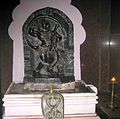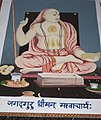
Koodli, also spelled Kudli or Kudali, is a small historic village in Shimoga District, in the Indian state of Karnataka. It is at the sangam (confluence) of two rivers, the Tunga River and Bhadra River at nearly 1,200 metres (3,937 ft). They meet here to give rise to the Tungabhadra River, a tributary of the Krishna river. Their valleys host many architectural sites. The village was a much larger town and pilgrimage center before the 14th-century, one destroyed during the Islamic-Hindu wars that followed. Important temples and their ruins here include the Sangamesvara temple, Ramesvara temple, Sri Chintamani Narasimha temple, Sringeri Vediki temple, Vishwakarma temple, Sharadamba temple, Amma Devasthana, and the Brahmeswara temple. Other scattered ruins of unknown temples are also found here.
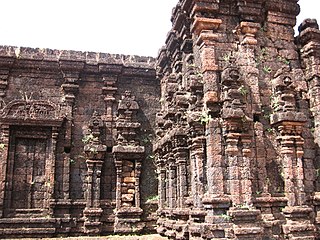
The Rajarajeshwara temple is a Shiva temple located in Taliparamba in Kannur district of Kerala, India. The temple is regarded as one of the existing 108 ancient Shiva Temples of ancient Kerala. It also has a prominent place amongst the numerous Shiva temples in South India. It had the tallest shikhara amongst the temples of its time. The Rajarajeshwara temple has a top of about 90 tonnes. If any problem is encountered in the other temples of South India, devotees seek a solution in this temple through a prashnam, a traditional method of astrological decision making. The prashnam is conducted on a peedha outside the temple.
Kollur Mookambika Temple is located at Kollur in Byndoor, Taluk of Udupi District in the region of Tulunadu and in the state of Karnataka, India. It is a Hindu temple dedicated to the Mother Goddess known as Mookambika Devi. It is situated in the foothills of Kodachadri hills, on the southern bank of Souparnika River. Being situated in the land between Gokarna and Kanyakumari, believed to be created by sage Parashurama. The main deity of the temple is a swayambhu (self-born) jyotirlinga with a golden line cutting it into half, in which the left half represents Tridevis, and the right half represents Trimurtis. Along with this, a four-handed panchaloha idol of Goddess Mookambika is also installed. There are sub-shrines for Ganapathi, Subrahmanya, Shiva, Vishnu, Virabhadra, Hanuman and Snake gods in the temple. Rathotsava in the month of Phalguna and Navaratri in the month of Ashwina are the main festivals in this temple. Goddess Mookambika is said to be the name given to Goddess Shakti after she killed the demon Mookasura. Though the temple is located in Karnataka, most number of devotees coming here are from the neighbouring state of Kerala. It is also one among the most popular shrines visited by Malayalis irrespective of religion and caste.

Kashi Math is a spiritual organisation followed by the Madhva section of Goud Saraswat Brahmins,who are also referred as Madhwa Saraswat Brahmins or Vaishnava Saraswat Brahmins. It dates back to the 16th century. With its headquarters in Brahma Ghat, Varanasi. Kashi Math has followers all over the Konkan belt, prominently in Mumbai, Goa, Udupi, Mangalore, Kochi and other parts of Karnataka and Kerala.
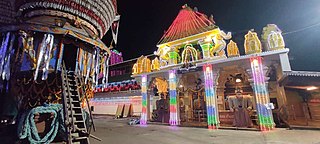
Paryaya is a religious ritual which takes place every alternate year in Sri Krishna Matha of Udupi. The puja and administration of Krishna Matha is distributed among the Swamijis of Ashta Matha's established by Dvaita philosopher Sri Madhvacharya. Each swamiji of every matha gets chance to perform puja to Udupi Sri Krishna by rotation for a period of two years.

The Krishnapur Matha or Krishnapur Mutt in some records and literature is a Madhwa Vaishnava monastery. It is one of the Ashta Mathas of Udupi founded by Dvaita philosopher Madhvacharya of Udupi. Krishnapur Monastery is currently headed by Vidyasagara Thirta. The first swami of this monastery was Janardhana Thirta, who was one of the direct disciples of Madhvacharya. Its presiding deity is Kalingamardhana Krishna. The matha houses a Mukyaprana temple inside where puja is performed every day.

Subramanya is a village located in Sullia Taluk in Dakshina Kannada, India. The Kukke Subrahmanya Temple is located here. It is about 105 kilometres (65 mi) from Mangalore, connected by train and road. It was originally named "Kukke Pattana".

Udupi Shri Krishna Temple is a well-known historic Hindu temple dedicated to Lord Krishna and Dvaita Matha located in the city of Udupi in Karnataka, India. The Matha area resembles a living Aashram, a holy place for daily devotion and living. Surrounding the Shri Krishna Temple are several temples namely the Udupi Anantheshwara Temple which is over a thousand years old.
Shakatapuram, also known by the name Bhandigadi, is a religious place for Hindus located in the Koppa taluk of the state of Karnataka, India. It is located near Sringeri and is situated on the banks of river Tunga. It is famous for a Hindu Math called Shri Vidya Peetam which is present at this place. The Kumbhabhishekam event held at this place attracts a number of devotees.

Shri Gokarna Math or Partagali Math is the first Gaud Saraswat Mathas of the Dvaita order, a system established by Jagadguru Madhvacharya in the 13th century AD. This matha also called Partagali Jivottama and is headquartered in Partagali, a small town in South Goa, on the banks of the river Kushavati.

Sri Vishwesha Tirtharu, officially known as Śrī Śrī 108 Śrī Viśveśa-tīrtha Śrīpādaṅgaḷavaru Kannada: ಶ್ರೀ ಶ್ರೀ ೧೦೮ ಶ್ರೀ ವಿಶ್ವೇಶತೀರ್ಥ ಶ್ರೀಪಾದಂಗಳವರು, was an Indian Hindu guru, saint and presiding swamiji of the Sri Pejavara Adokshaja Matha, one of the Ashta Mathas belonging to the Dvaita school of philosophy founded by Sri Madhvacharya. Sri Vishvesha Tirtharu was the 32nd in the lineage of the Pejavara matha, starting from Sri Adhokshaja Tirtharu, who was one of the direct disciples of Sri Madhvacharya. He was the honorary president of Vishva Tulu Sammelana. He had established Poornaprajna Vidyapeetha in Bangalore which has completed over 63 years. Many scholars are trained here on Vedanta. He has also conducted 38 Nyayasudamangalas - graduations for Poornaprajna Vidyapeetha students. He was awarded the Padma Vibhushan India's second highest civilian award posthumously in 2020 for his work and service towards the society.

Madhva Traditon (originally named Sadh Vaishnavism and Brahma Sampradaya, is a denomination within the Vaishnavism—Bhagavata tradition of Hinduism, founded by the thirteenth century philosopher Madhvacharya. It is a movement in Hinduism that developed during its classical period around the beginning of the Common Era. Philosophically, Madhva tradition is aligned with Dvaita Vedanta, and regards Madhvacharya as its founder or reformer.

Puthige Matha or Puttige Mutt in some records and literature is a Madhwa Vaishnava monastery. It is one of the Ashta Mathas of Udupi founded by Dvaita philosopher Madhvacharya of Udupi. The first pontiff of Puttige matha was Sri Upendra Tirtha, who was a direct disciple of Sri Madhvacharya, the founder of the Dvaita school of philosophy. The main idols worshipped in the Puttige matha are that of Panduranga (Vittala), which was given to Sri Upendra Tirtha by Sri Madhvacharya. Till date, there have been 29 pontiffs who have headed the matha.

Shri Uttaradi Math, is one of the premier monasteries (matha) founded by Madhvacharya to preserve and propagate Sanatana dharma and Dvaita Vedanta (Tattvavada) with Padmanabha Tirtha as its head. The Uttaradi Math is an important institution among the Madhvas and also deeply respected among the Vaishnavas and the other Hindus. Most of the Deshastha Madhvas and majority of Madhvas outside Tulu Nadu region are followers of this matha. Uttaradi Math has followers across Karnataka (outside Tulunadu region), Maharashtra, Andhra Pradesh, Telangana, Madhya Pradesh, Tamil Nadu and Bihar regions.
Nava Brindavana ;, is located on an island in the Tungabhadra River at Anegundi, near Hampi, Karnataka, India. The Bruindavanas of nine Hindu Madhva saints present in Nava Brindavana belongs to the Uttaradi Math, Vyasaraja Math and Raghavendra Math. All these saints are descended from Padmanabha Tirtha, direct disciple of Jagadguru Madhvacharya.

Sri Satyatma Tirtha, is an Indian Hindu philosopher, guru, scholar, spiritual leader, saint and the present pontiff of Uttaradi Math. He is the 42nd pontiff of Uttaradi Math since Madhvacharya, the chief proponent and the one who rejuvenated the Dvaita philosophy (Tattvavada). Satyatma Tirtha founded Vishwa Madhwa Maha Parishat, a non-profit, religious and social organization in 1998.
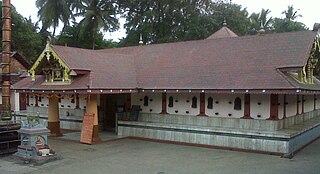
The Sri Lakshmi Narasimha Temple is the foremost temple of Gowda Saraswatha Brahmins in and around Thalassery.
Shenbakkam Raghavendra Swami Mutt is an ancient temple located on the banks of the Palar river, in Vellore district, Shenbakkam. It is located in the Indian state of Tamil Nadu around 130 km from Chennai and 200 km from Bangalore.
Betrayaswamy temple in Denkanikottai town in Krishnagiri district in the South Indian state of Tamil Nadu, is dedicated to the Hindu god Vishnu. It is located 22 km from Hosur and 60 km from Bangalore. Constructed in the Hoysala style of architecture, the temple is dedicated to Vishnu who is worshipped as Devaperumal and his consort Lakshmi as Soundaryavalli in this temple.

Satyabodha Tirtha was an Indian philosopher, scholar, yogi, mystic and saint. He was the 25th pontiff of Uttaradi Math and served the pontificate from March 1744 - 9 March 1783. Satyabodha Tirtha was a great yogi and was honoured by both Hindu and Muslim rulers of his time. Satyabodha Tirtha enjoyed a good fame as a miracle-man. Almost all the princes of the South India used to worship him and were his ardent disciples. Murari Rao of Gooty, Raghoji Bhosale and Fateh Singh Rao Gaekwad, were his great disciples. Satyabodha Tirtha Swamiji's mission of peace has played a prominent role during this time. He earned a reputation as the greatest of Madhva saints of his time for his un-rivaled scholarship, miraculous achievements and dynamism as the pontiff of the Uttaradi Math. So many were his achievements and so well was he liked, admired and respected by people of all castes and creeds, rich and poor, that the Uttaradi Math in Savanur got the name as Satyabodha Math after him.





